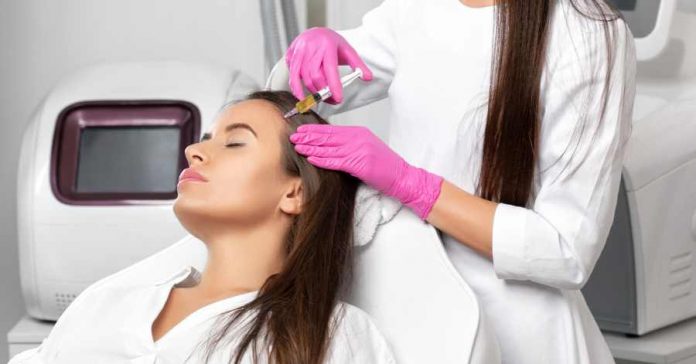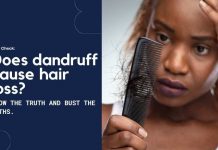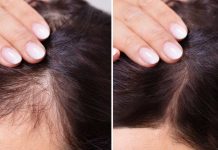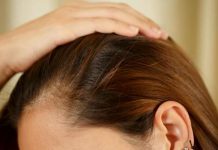Your hair plays a vital role in enhancing your overall appearance. Your long, voluminous locks plays a crucial role in boosting your self-confidence when meeting someone for the first time. But what if you are losing more hair than usual? Receding hairline is a common issue that we face as we advance in age. Advancement in the field of haircare has presented us with safe and effective method called Platelet-Rich Plasma or PRP treatment[1.
PRP hair treatment method has gained immense popularity in recent times[2], as several studies reveal that it is efficient in improving hair growth[3]. No wonder it is one of the most preferred hair growth treatments in the field of plastic surgery[4]. If you are looking forward to flaunting healthy and fuller hair, read on why PRP treatment is right for you.
About PRP Hair Treatment

Platelet-rich plasma treatment is a safe non-surgical treatment option for hair regrowth[5]. This hair treatment uses the blood drawn out of your body to kindle scalp hair growth. It is based on plasma, your blood’s liquid part, and platelets, particular protein components known as growth factors. These growth factors play a crucial role in tissue regeneration and promote the natural healing process in your body. When the PRP extracted from your blood is injected into your scalp, its growth factors replace or repair the damaged scalp cells while enhancing the healing process.
The PRP treatment is ideal for hair restoration with a fuller and healthier mane when suffering from male pattern baldness, androgenetic alopecia, post-natal symptoms, and menopause. Androgenetic alopecia causes hair follicle shrinkage, slows hair growth, and produces very thin or fine hair. With time, the shrunken hair follicles fail to grow new hair. This is why PRP works[6], as a study reveals that it was effective for both men and women dealing with androgenetic alopecia[7]. This PRP treatment is ideal if you want a non-invasive treatment for inducing hair growth naturally with less discomfort and downtime.
| Parameter | Clinical Explanation |
|---|---|
| PRP Therapy | Autologous platelet-rich plasma is administered via intradermal injections to stimulate follicular regeneration for hair regrowth |
| Duration of Procedure | Approximately 1-1.5 hours |
| Level of Discomfort | Mild to moderate discomfort |
| Financial Investment | Ranges from Rs. 5000 to Rs. 10,000 per session |
| Number of Sessions | Best outcomes after a course of 3-4 treatment sessions |
| Interval Between Treatments | Inter-session period of 4-6 weeks |
| Potential Side Effects | Limited to transient erythema, edema, or ecchymosis at the injection site |
| Efficacy | Improved follicular density and strand caliber in a significant proportion of cases (Source) |
| Patient Profile | People with hair thinning issues but not complete alopecia or bald |
| Longevity of the procedure | Up to one year, maintenance treatments should be carried out for long-term benefit |
PRP Hair Treatment Procedure
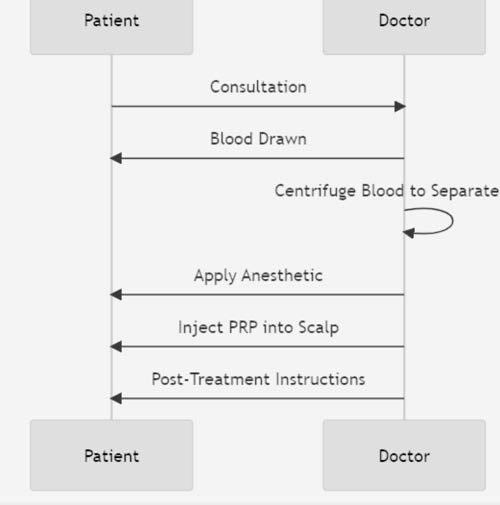
The Platelet-Rich Plasma treatment involves a couple of steps and needs three sessions with a gap between four and six weeks. You might have to undergo maintenance treatment once every four to six months. The following are the steps involved in the Platelet-Rich Plasma treatment procedure:
1st Step
Blood Sample Collection and Platelet Separation: Your doctor will draw around 30 ml of blood from your arm. It is then spun in a centrifuge to separate platelets from it. It is based on the double-spun centrifuge method for optimum platelet concentration, which is loaded with optimum hair growth factors[8].
2nd Step
Activating the Extracted PRP from Blood: After 10 minutes in a centrifuge, your blood will be divided into three layers: red blood cells, platelet-rich plasma, and platelet-poor plasma. Your doctor will extract the PRP from the test tube from platelet-poor plasma or PPP layers and RBCs or Red Blood Cells. This extracted PRP will have five times the regular amount of platelets than the ones found in your blood. Then, the trichologist will perform growth factor activation on the collected plasma with the help of activating agents.
3rd Step
Injecting PRP On the Targeted Site: During this last step, your dermatologist will inject the extracted Platelet-Rich Plasma safely into the targeted region in your scalp using microneedles. Before Platelet-Rich Plasma is inserted, your dermatologist might administer local anesthesia in the margin of your scalp to numb it.
Benefits of PRP Hair Treatment Procedure
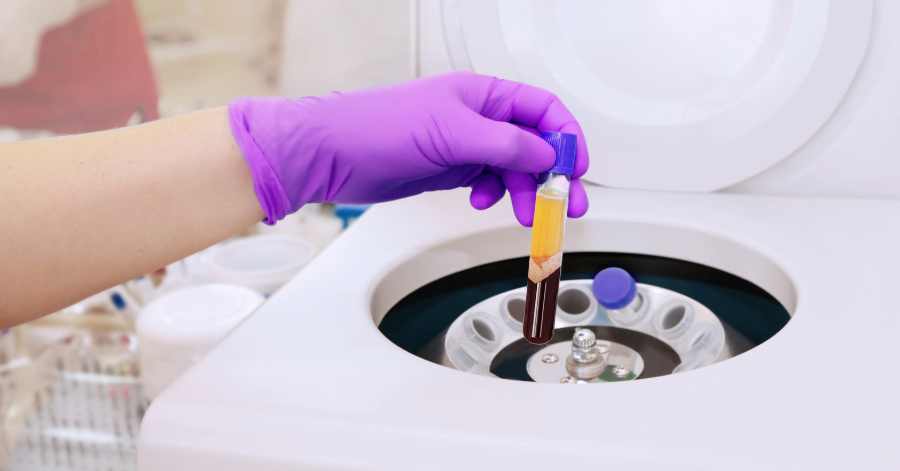
As the Platelet-Rich Plasma treatment harnesses your body’s growth factors and healing properties, it is a practical choice for promoting healthy hair regrowth. These reasons would tell you why Platelet-Rich Plasma treatment remains the most preferred hair restoration procedure.
1. Treats Hair Loss
Being an autologous treatment, PRP utilizes the patient’s blood sample to create a potent solution with a rich concentration of platelets. This combination of plasma and platelets loaded with essential growth factors helps improve cell regeneration and repair hair follicle damage and scalp tissues in the affected area. It promotes blood flow and supplies nutrients to your scalp cells to kindle the dormant hair follicles. So, the inactive hair follicles go through a growth stage and cycle transition to promote hair regrowth with strong and healthy strands.
2. Non-Invasive Hair Procedure
This advanced hair treatment procedure draws blood, separates platelets from RBCs and WBCs, and injects the prepared PRP serum on the scalp using microneedles. So, no incisions or cuts are made on your scalp during this treatment.
3. Open to Customization
Platelet-rich plasma treatment is ideal for all hair loss types and people of different ages. It is a versatile treatment that can be personalized based on unique hair loss symptoms and hair health to ensure positive hair growth results.
4. Higher Rate of Success
Dermatologists suggest Platelet-Rich Plasma treatment for hair growth, as it can significantly improve hair count and density in a couple of sessions. This treatment has better success rates and optimum satisfaction when opting for a PRP hair treatment procedure at a reputed clinic with experienced hair restoration specialists. In a study, it was found that 1,484,555.6 platelets per microliter of PRP sample preparation were found to stimulate follicular and perifollicular angiogenesis. It is a major factor in hair growth. The study was done for male androgenic alopecia and was very effective, with negligible side effects. [9]
5. Permanent Hair Growth Outcome
PRP hair treatment delivers lasting hair regrowth effects when coupled with regular maintenance procedures. With proper follow-up treatments, you can enhance the health of hair follicles and promote continuous hair growth with high density. A study done at Smt Kashibai Navale Medical College found that PRP injection has an overall patient satisfaction when it comes to hair growth for the long term [10].
6. No Side Effects / Downtime
As it is a non-surgical hair loss treatment method, you can perform your everyday activities soon after getting these PRP injections. This therapy with Platelet-Rich Plasma doesn’t have serious side effects and risks compared to other hair loss surgeries. As the PRP shots are made using your blood components, there are no allergic reactions or fatal side effects[11].
What to Expect After PRP Hair Treatment Procedure?
There is no PRP hair treatment procedure downtime, so that you can return to work after the appointment. After the procedure, some might have a bit of swelling, redness, or tenderness on the injection site, which will go away within two days. However, avoiding exercises for a few days after the PRP treatment is essential to let it heal quickly. Waiting for some to see the visible results and benefits of the PRP hair treatment procedure is necessary.
The first outcome you will notice is a gradual reduction in hair loss. After two weeks of the PRP treatment, you will see a considerable improvement in the quality and texture of your hair. Between three and six months, you can find the optimum effect of the PRP hair treatment, which includes very healthy and thicker hair strands.
Side Effects of PRP Hair Treatment
Even though PRP Hair Treatment is safe, you must stay aware of some side effects one might experience after a session.
- Discomfort/Pain: Some may have slight discomfort or mild pain after getting a PRP hair injection treatment.
- Inflammation: Experiencing inflammation or swelling is a common side effect of PRP hair procedures. It will subside within 48 hours.
- Allergic Reaction: Allergic reactions are rare, as PRP treatment is based on the patient’s blood. However, ensure that your doctor is informed if you have allergies before the procedure.
- Reddish skin or Bruising: It is normal to develop reddish skin or Bruising at the site of injection. There is no need for any concerns as it is a temporary and mild side effect.
Safety Considerations
PRP Hair Treatment is a safe procedure that makes it an ideal choice for people of different ages. However, discuss your options with your doctor if you have any underlying medical condition like chronic skin or liver disorder, lupus, low platelet count, cancer, thyroid, or metabolic issues. If you are an alcoholic or a heavy smoker, you are not eligible for PRP Hair Treatment.
Suitable Candidates for PRP Hair Treatment
You can opt for a PRP hair treatment if you have healthy hair follicles at the early stage of hair loss. It is beneficial for people with receding hairline and visible thinning areas. Patients dealing with female or male pattern baldness, telogen effluvium, and alopecia areata are also suitable candidates for PRP.
Cost of PRP Hair Treatment
India’s average PRP hair procedure cost is from INR 4,500 to INR 15,000 per PRP session. The price might vary based on factors like the clinic’s reputation, the equipment used for the procedure, and the number of sessions needed. Do check out our detailed article on cost of PRP treatment in India.
Maintenance after PRP Hair Procedure
- Use a pH-balanced shampoo to wash hair.
- Avoid using hair products for a minimum of 6 hours after your PRP treatment.
- After the treatment, wash your hair and take a hot shower before going to bed to enhance the effects of PRP.
- Do not smoke. Use caffeine or alcohol-based drinks for three days after getting PRP shots. These habits might prevent quick healing, which will take a long time.
- Avoid using blood thinners, Minoxidil for 7 to 10 days after the PRP procedure.
- Add hair growth and regrowth foods in your diet.
To get the most out of your PRP hair treatment procedure, schedule an appointment at the Kolors Healthcare Center. The trichologists at their advanced hair and skin clinic will tell you how the PRP treatment would benefit your hair loss. Put an end to your hair loss issue and experience healthy hair regrowth.
References
- Cleveland Clinic, Cleveland, OH, USA. – https://journals.lww.com/
- Xianhui Li BMs, Junqing Gao BMs, Haishan Zheng BMs – https://onlinelibrary.wiley.com/doi/10.1111/jocd.15653
- Sophie K. Hasiba-Pappas; Alexandru Cristian Tuca; Hanna Luze – https://karger.com/tmh
- American Society of Plastic Surgeons – https://www.plasticsurgery.org
- www.wolterskluwer.com – https://www.plasticsurgery.org
- Institute of Dermatology, F. Policlinico Gemelli IRCSS, Italy – https://art.torvergata.it
- International Society of Hair Restoration Surgery (ISHRS), Ad Hoc Committee on PRP – https://pubmed.ncbi.nlm.nih.gov/30882509/
- School of Anti-Aging and Regenerative Medicine, Mae Fah Luang University, Bangkok, Thailand – https://www.ncbi.nlm.nih.gov/pmc/articles/PMC8922312/
- Plastic and Reconstructive Surgery Department, University of Rome “Tor Vergata,” Rome, Italy – https://www.ncbi.nlm.nih.gov/pmc/articles/PMC4622412/
- Department of Dermatology, Venereology, and Leprosy, Smt Kashibai Navale Medical College, Pune, Maharashtra, India – https://www.ncbi.nlm.nih.gov/pmc/articles/PMC4134641/
- Laboratory of Medical Statistics, Democritus University of Thrace, Alexandroupolis, Greece – https://www.ncbi.nlm.nih.gov/pmc/articles/PMC4338465/

